Contract and Negligence Law Report
VerifiedAdded on 2020/01/28
|14
|4142
|135
Report
AI Summary
This report delves into the critical aspects of contract and negligence law, outlining essential elements, types of contracts, and various case laws. It discusses the principles of liability in tort and contractual relationships, providing a comprehensive understanding of legal obligations and rights. The report emphasizes the importance of case law in interpreting these legal concepts and concludes with a summary of the vital role these laws play in protecting the interests of parties involved.

ACNB
1
1
Paraphrase This Document
Need a fresh take? Get an instant paraphrase of this document with our AI Paraphraser
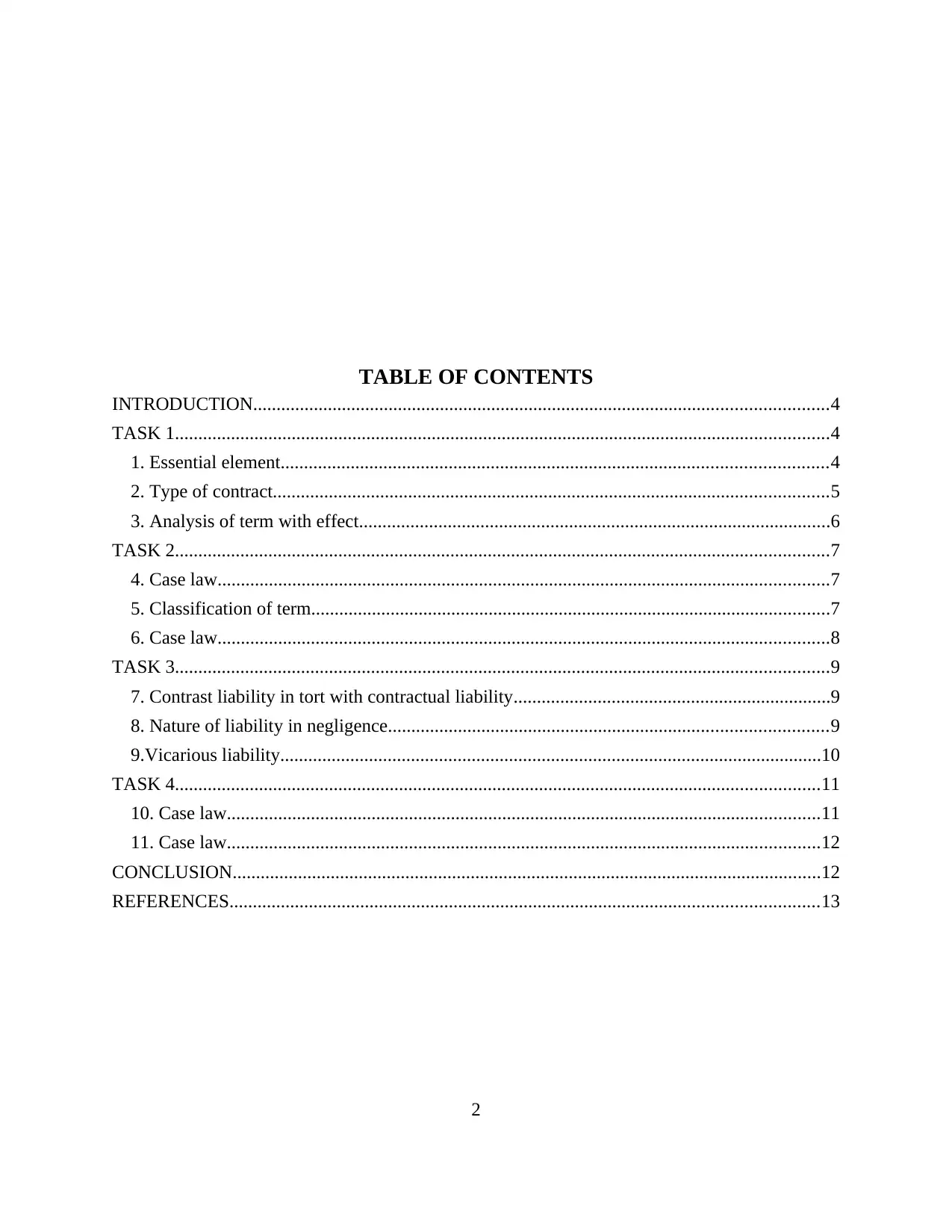
TABLE OF CONTENTS
INTRODUCTION...........................................................................................................................4
TASK 1............................................................................................................................................4
1. Essential element.....................................................................................................................4
2. Type of contract.......................................................................................................................5
3. Analysis of term with effect.....................................................................................................6
TASK 2............................................................................................................................................7
4. Case law...................................................................................................................................7
5. Classification of term...............................................................................................................7
6. Case law...................................................................................................................................8
TASK 3............................................................................................................................................9
7. Contrast liability in tort with contractual liability....................................................................9
8. Nature of liability in negligence..............................................................................................9
9.Vicarious liability....................................................................................................................10
TASK 4..........................................................................................................................................11
10. Case law...............................................................................................................................11
11. Case law...............................................................................................................................12
CONCLUSION..............................................................................................................................12
REFERENCES..............................................................................................................................13
2
INTRODUCTION...........................................................................................................................4
TASK 1............................................................................................................................................4
1. Essential element.....................................................................................................................4
2. Type of contract.......................................................................................................................5
3. Analysis of term with effect.....................................................................................................6
TASK 2............................................................................................................................................7
4. Case law...................................................................................................................................7
5. Classification of term...............................................................................................................7
6. Case law...................................................................................................................................8
TASK 3............................................................................................................................................9
7. Contrast liability in tort with contractual liability....................................................................9
8. Nature of liability in negligence..............................................................................................9
9.Vicarious liability....................................................................................................................10
TASK 4..........................................................................................................................................11
10. Case law...............................................................................................................................11
11. Case law...............................................................................................................................12
CONCLUSION..............................................................................................................................12
REFERENCES..............................................................................................................................13
2

3
⊘ This is a preview!⊘
Do you want full access?
Subscribe today to unlock all pages.

Trusted by 1+ million students worldwide
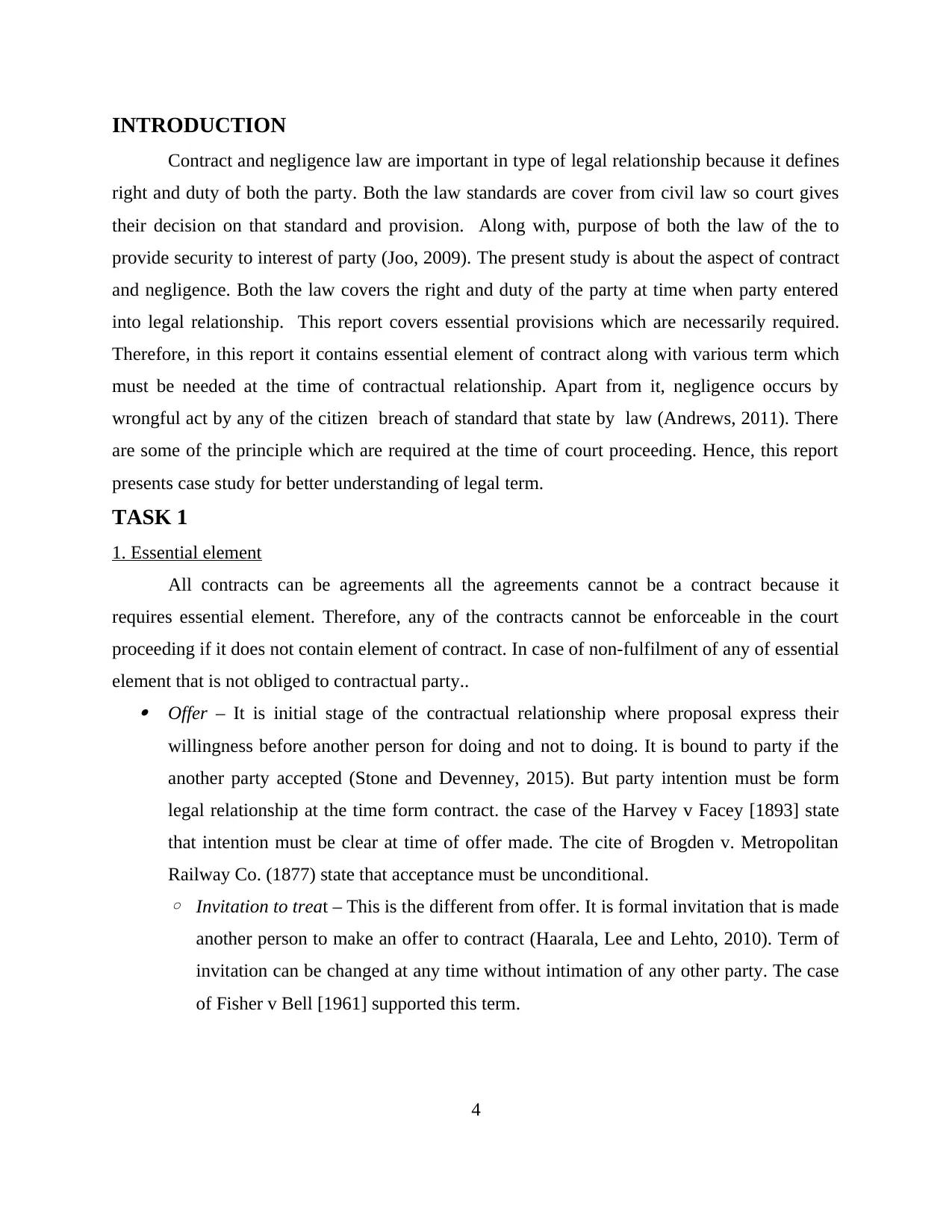
INTRODUCTION
Contract and negligence law are important in type of legal relationship because it defines
right and duty of both the party. Both the law standards are cover from civil law so court gives
their decision on that standard and provision. Along with, purpose of both the law of the to
provide security to interest of party (Joo, 2009). The present study is about the aspect of contract
and negligence. Both the law covers the right and duty of the party at time when party entered
into legal relationship. This report covers essential provisions which are necessarily required.
Therefore, in this report it contains essential element of contract along with various term which
must be needed at the time of contractual relationship. Apart from it, negligence occurs by
wrongful act by any of the citizen breach of standard that state by law (Andrews, 2011). There
are some of the principle which are required at the time of court proceeding. Hence, this report
presents case study for better understanding of legal term.
TASK 1
1. Essential element
All contracts can be agreements all the agreements cannot be a contract because it
requires essential element. Therefore, any of the contracts cannot be enforceable in the court
proceeding if it does not contain element of contract. In case of non-fulfilment of any of essential
element that is not obliged to contractual party.. Offer – It is initial stage of the contractual relationship where proposal express their
willingness before another person for doing and not to doing. It is bound to party if the
another party accepted (Stone and Devenney, 2015). But party intention must be form
legal relationship at the time form contract. the case of the Harvey v Facey [1893] state
that intention must be clear at time of offer made. The cite of Brogden v. Metropolitan
Railway Co. (1877) state that acceptance must be unconditional.
◦ Invitation to treat – This is the different from offer. It is formal invitation that is made
another person to make an offer to contract (Haarala, Lee and Lehto, 2010). Term of
invitation can be changed at any time without intimation of any other party. The case
of Fisher v Bell [1961] supported this term.
4
Contract and negligence law are important in type of legal relationship because it defines
right and duty of both the party. Both the law standards are cover from civil law so court gives
their decision on that standard and provision. Along with, purpose of both the law of the to
provide security to interest of party (Joo, 2009). The present study is about the aspect of contract
and negligence. Both the law covers the right and duty of the party at time when party entered
into legal relationship. This report covers essential provisions which are necessarily required.
Therefore, in this report it contains essential element of contract along with various term which
must be needed at the time of contractual relationship. Apart from it, negligence occurs by
wrongful act by any of the citizen breach of standard that state by law (Andrews, 2011). There
are some of the principle which are required at the time of court proceeding. Hence, this report
presents case study for better understanding of legal term.
TASK 1
1. Essential element
All contracts can be agreements all the agreements cannot be a contract because it
requires essential element. Therefore, any of the contracts cannot be enforceable in the court
proceeding if it does not contain element of contract. In case of non-fulfilment of any of essential
element that is not obliged to contractual party.. Offer – It is initial stage of the contractual relationship where proposal express their
willingness before another person for doing and not to doing. It is bound to party if the
another party accepted (Stone and Devenney, 2015). But party intention must be form
legal relationship at the time form contract. the case of the Harvey v Facey [1893] state
that intention must be clear at time of offer made. The cite of Brogden v. Metropolitan
Railway Co. (1877) state that acceptance must be unconditional.
◦ Invitation to treat – This is the different from offer. It is formal invitation that is made
another person to make an offer to contract (Haarala, Lee and Lehto, 2010). Term of
invitation can be changed at any time without intimation of any other party. The case
of Fisher v Bell [1961] supported this term.
4
Paraphrase This Document
Need a fresh take? Get an instant paraphrase of this document with our AI Paraphraser
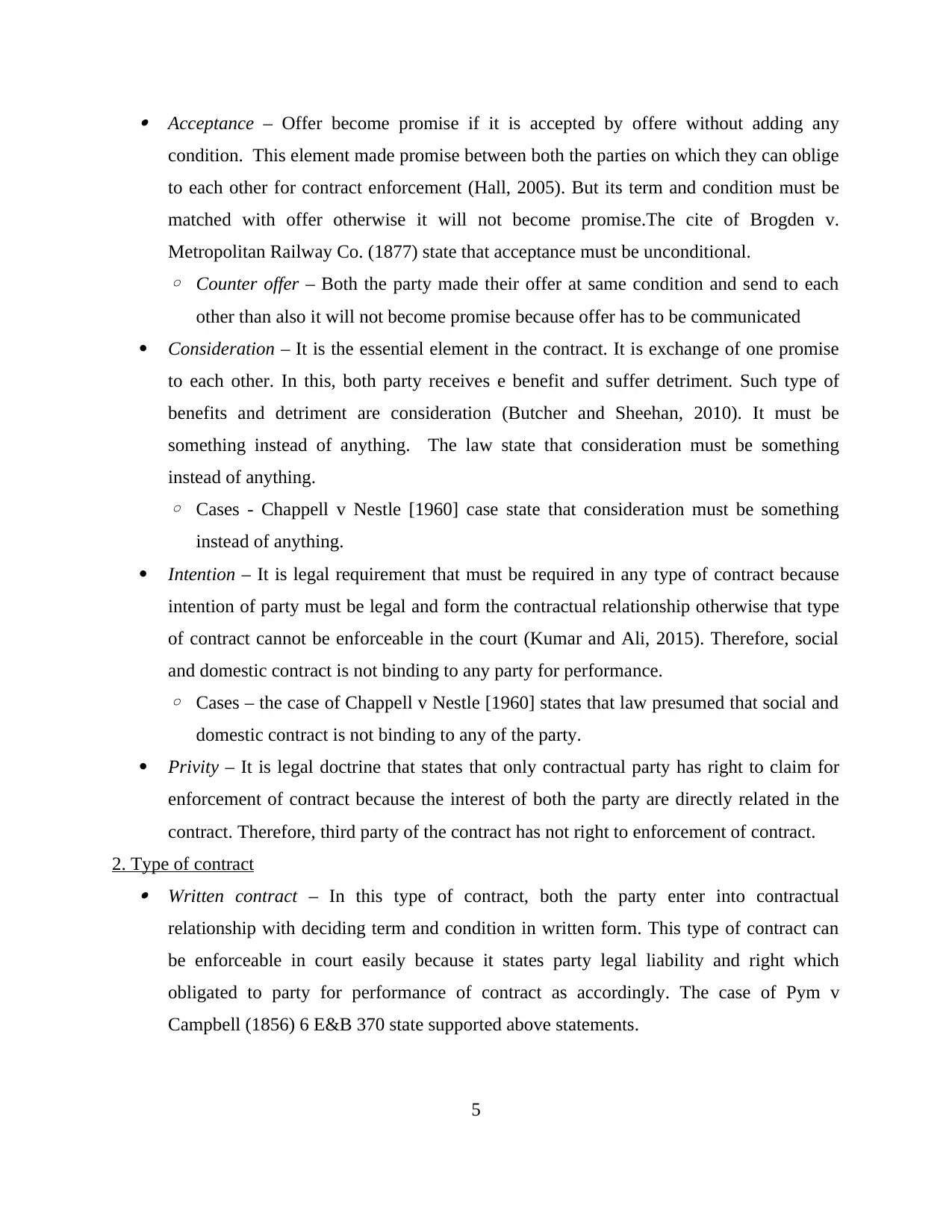
Acceptance – Offer become promise if it is accepted by offere without adding any
condition. This element made promise between both the parties on which they can oblige
to each other for contract enforcement (Hall, 2005). But its term and condition must be
matched with offer otherwise it will not become promise.The cite of Brogden v.
Metropolitan Railway Co. (1877) state that acceptance must be unconditional.
◦ Counter offer – Both the party made their offer at same condition and send to each
other than also it will not become promise because offer has to be communicated
Consideration – It is the essential element in the contract. It is exchange of one promise
to each other. In this, both party receives e benefit and suffer detriment. Such type of
benefits and detriment are consideration (Butcher and Sheehan, 2010). It must be
something instead of anything. The law state that consideration must be something
instead of anything.
◦ Cases - Chappell v Nestle [1960] case state that consideration must be something
instead of anything.
Intention – It is legal requirement that must be required in any type of contract because
intention of party must be legal and form the contractual relationship otherwise that type
of contract cannot be enforceable in the court (Kumar and Ali, 2015). Therefore, social
and domestic contract is not binding to any party for performance.
◦ Cases – the case of Chappell v Nestle [1960] states that law presumed that social and
domestic contract is not binding to any of the party.
Privity – It is legal doctrine that states that only contractual party has right to claim for
enforcement of contract because the interest of both the party are directly related in the
contract. Therefore, third party of the contract has not right to enforcement of contract.
2. Type of contract Written contract – In this type of contract, both the party enter into contractual
relationship with deciding term and condition in written form. This type of contract can
be enforceable in court easily because it states party legal liability and right which
obligated to party for performance of contract as accordingly. The case of Pym v
Campbell (1856) 6 E&B 370 state supported above statements.
5
condition. This element made promise between both the parties on which they can oblige
to each other for contract enforcement (Hall, 2005). But its term and condition must be
matched with offer otherwise it will not become promise.The cite of Brogden v.
Metropolitan Railway Co. (1877) state that acceptance must be unconditional.
◦ Counter offer – Both the party made their offer at same condition and send to each
other than also it will not become promise because offer has to be communicated
Consideration – It is the essential element in the contract. It is exchange of one promise
to each other. In this, both party receives e benefit and suffer detriment. Such type of
benefits and detriment are consideration (Butcher and Sheehan, 2010). It must be
something instead of anything. The law state that consideration must be something
instead of anything.
◦ Cases - Chappell v Nestle [1960] case state that consideration must be something
instead of anything.
Intention – It is legal requirement that must be required in any type of contract because
intention of party must be legal and form the contractual relationship otherwise that type
of contract cannot be enforceable in the court (Kumar and Ali, 2015). Therefore, social
and domestic contract is not binding to any party for performance.
◦ Cases – the case of Chappell v Nestle [1960] states that law presumed that social and
domestic contract is not binding to any of the party.
Privity – It is legal doctrine that states that only contractual party has right to claim for
enforcement of contract because the interest of both the party are directly related in the
contract. Therefore, third party of the contract has not right to enforcement of contract.
2. Type of contract Written contract – In this type of contract, both the party enter into contractual
relationship with deciding term and condition in written form. This type of contract can
be enforceable in court easily because it states party legal liability and right which
obligated to party for performance of contract as accordingly. The case of Pym v
Campbell (1856) 6 E&B 370 state supported above statements.
5
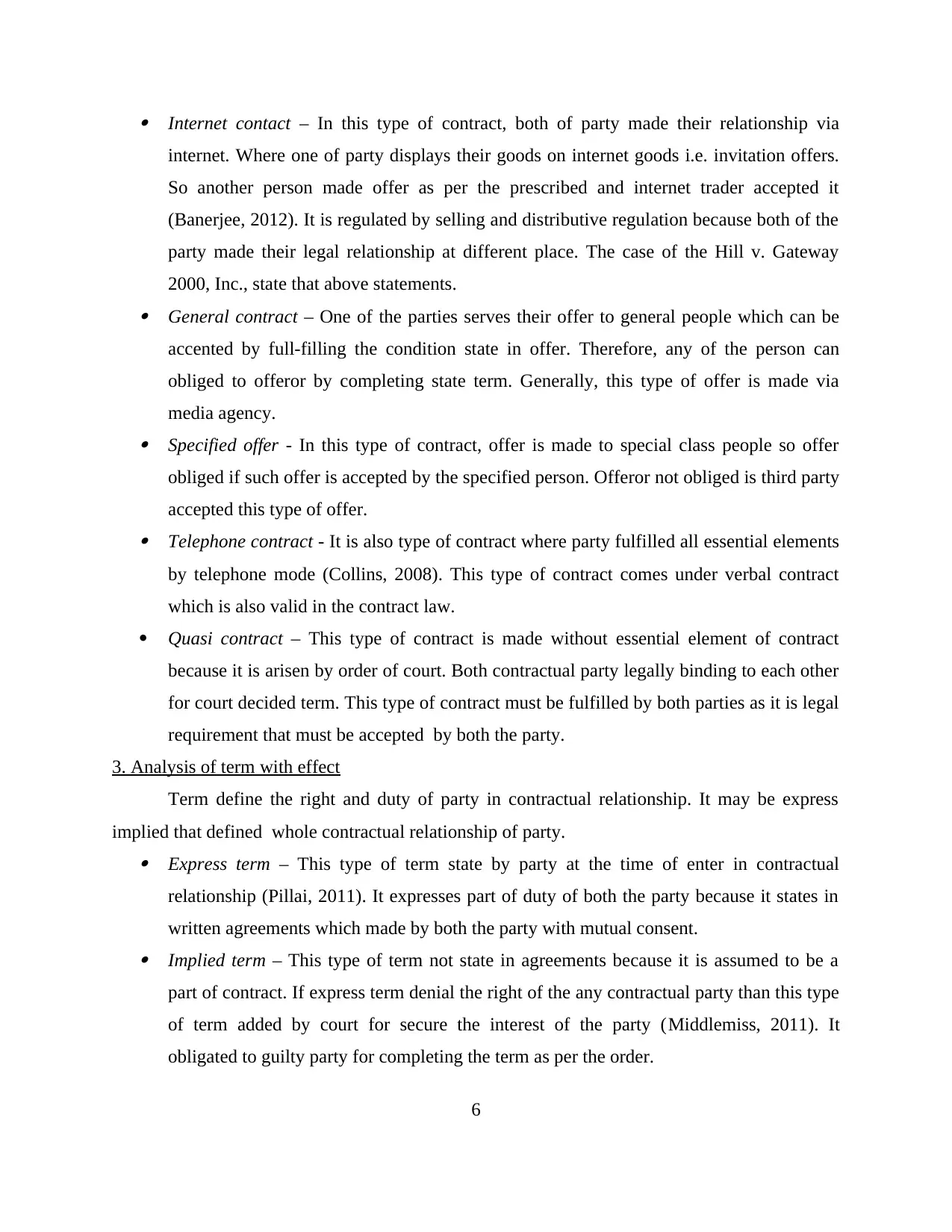
Internet contact – In this type of contract, both of party made their relationship via
internet. Where one of party displays their goods on internet goods i.e. invitation offers.
So another person made offer as per the prescribed and internet trader accepted it
(Banerjee, 2012). It is regulated by selling and distributive regulation because both of the
party made their legal relationship at different place. The case of the Hill v. Gateway
2000, Inc., state that above statements. General contract – One of the parties serves their offer to general people which can be
accented by full-filling the condition state in offer. Therefore, any of the person can
obliged to offeror by completing state term. Generally, this type of offer is made via
media agency. Specified offer - In this type of contract, offer is made to special class people so offer
obliged if such offer is accepted by the specified person. Offeror not obliged is third party
accepted this type of offer. Telephone contract - It is also type of contract where party fulfilled all essential elements
by telephone mode (Collins, 2008). This type of contract comes under verbal contract
which is also valid in the contract law.
Quasi contract – This type of contract is made without essential element of contract
because it is arisen by order of court. Both contractual party legally binding to each other
for court decided term. This type of contract must be fulfilled by both parties as it is legal
requirement that must be accepted by both the party.
3. Analysis of term with effect
Term define the right and duty of party in contractual relationship. It may be express
implied that defined whole contractual relationship of party. Express term – This type of term state by party at the time of enter in contractual
relationship (Pillai, 2011). It expresses part of duty of both the party because it states in
written agreements which made by both the party with mutual consent. Implied term – This type of term not state in agreements because it is assumed to be a
part of contract. If express term denial the right of the any contractual party than this type
of term added by court for secure the interest of the party (Middlemiss, 2011). It
obligated to guilty party for completing the term as per the order.
6
internet. Where one of party displays their goods on internet goods i.e. invitation offers.
So another person made offer as per the prescribed and internet trader accepted it
(Banerjee, 2012). It is regulated by selling and distributive regulation because both of the
party made their legal relationship at different place. The case of the Hill v. Gateway
2000, Inc., state that above statements. General contract – One of the parties serves their offer to general people which can be
accented by full-filling the condition state in offer. Therefore, any of the person can
obliged to offeror by completing state term. Generally, this type of offer is made via
media agency. Specified offer - In this type of contract, offer is made to special class people so offer
obliged if such offer is accepted by the specified person. Offeror not obliged is third party
accepted this type of offer. Telephone contract - It is also type of contract where party fulfilled all essential elements
by telephone mode (Collins, 2008). This type of contract comes under verbal contract
which is also valid in the contract law.
Quasi contract – This type of contract is made without essential element of contract
because it is arisen by order of court. Both contractual party legally binding to each other
for court decided term. This type of contract must be fulfilled by both parties as it is legal
requirement that must be accepted by both the party.
3. Analysis of term with effect
Term define the right and duty of party in contractual relationship. It may be express
implied that defined whole contractual relationship of party. Express term – This type of term state by party at the time of enter in contractual
relationship (Pillai, 2011). It expresses part of duty of both the party because it states in
written agreements which made by both the party with mutual consent. Implied term – This type of term not state in agreements because it is assumed to be a
part of contract. If express term denial the right of the any contractual party than this type
of term added by court for secure the interest of the party (Middlemiss, 2011). It
obligated to guilty party for completing the term as per the order.
6
⊘ This is a preview!⊘
Do you want full access?
Subscribe today to unlock all pages.

Trusted by 1+ million students worldwide
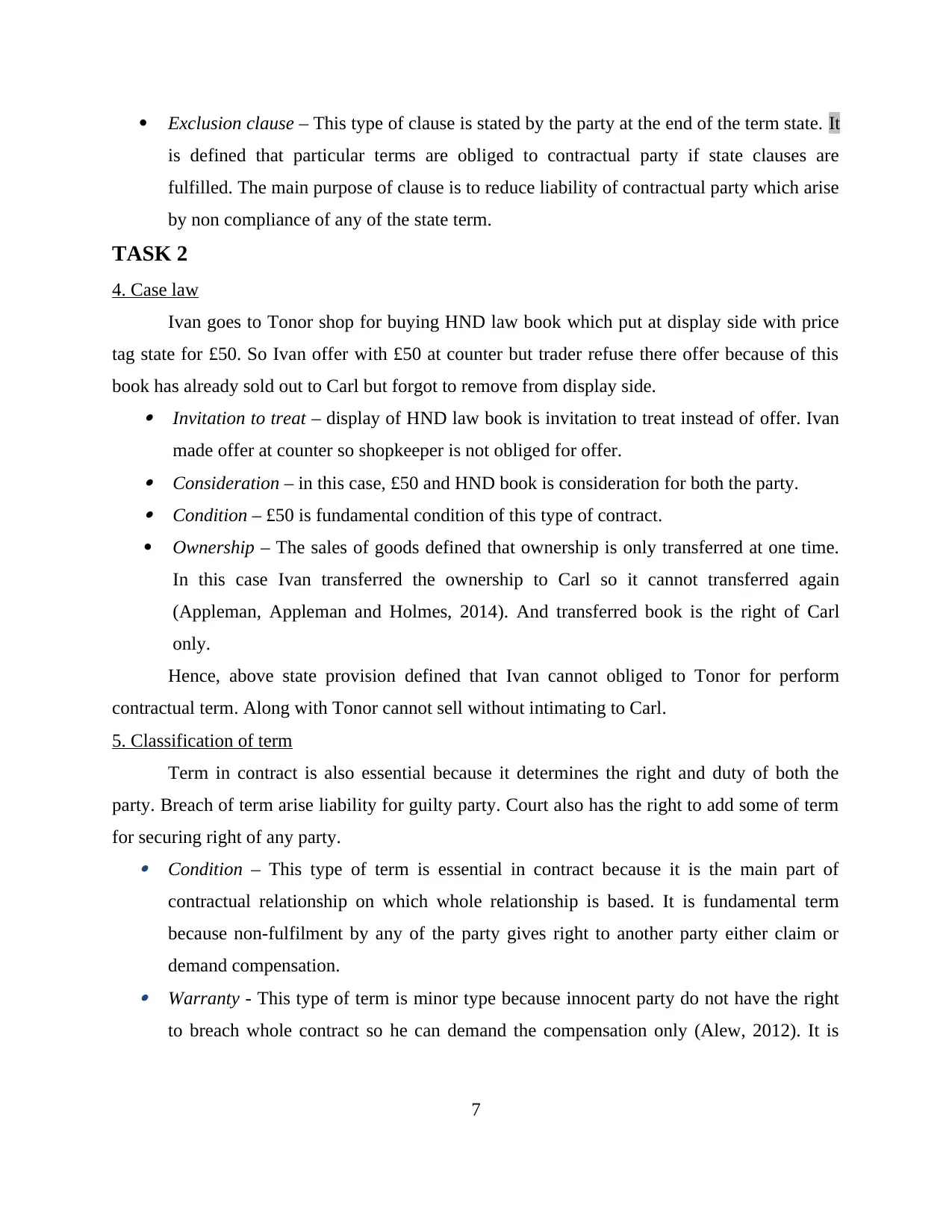
Exclusion clause – This type of clause is stated by the party at the end of the term state. It
is defined that particular terms are obliged to contractual party if state clauses are
fulfilled. The main purpose of clause is to reduce liability of contractual party which arise
by non compliance of any of the state term.
TASK 2
4. Case law
Ivan goes to Tonor shop for buying HND law book which put at display side with price
tag state for £50. So Ivan offer with £50 at counter but trader refuse there offer because of this
book has already sold out to Carl but forgot to remove from display side. Invitation to treat – display of HND law book is invitation to treat instead of offer. Ivan
made offer at counter so shopkeeper is not obliged for offer. Consideration – in this case, £50 and HND book is consideration for both the party. Condition – £50 is fundamental condition of this type of contract.
Ownership – The sales of goods defined that ownership is only transferred at one time.
In this case Ivan transferred the ownership to Carl so it cannot transferred again
(Appleman, Appleman and Holmes, 2014). And transferred book is the right of Carl
only.
Hence, above state provision defined that Ivan cannot obliged to Tonor for perform
contractual term. Along with Tonor cannot sell without intimating to Carl.
5. Classification of term
Term in contract is also essential because it determines the right and duty of both the
party. Breach of term arise liability for guilty party. Court also has the right to add some of term
for securing right of any party. Condition – This type of term is essential in contract because it is the main part of
contractual relationship on which whole relationship is based. It is fundamental term
because non-fulfilment by any of the party gives right to another party either claim or
demand compensation. Warranty - This type of term is minor type because innocent party do not have the right
to breach whole contract so he can demand the compensation only (Alew, 2012). It is
7
is defined that particular terms are obliged to contractual party if state clauses are
fulfilled. The main purpose of clause is to reduce liability of contractual party which arise
by non compliance of any of the state term.
TASK 2
4. Case law
Ivan goes to Tonor shop for buying HND law book which put at display side with price
tag state for £50. So Ivan offer with £50 at counter but trader refuse there offer because of this
book has already sold out to Carl but forgot to remove from display side. Invitation to treat – display of HND law book is invitation to treat instead of offer. Ivan
made offer at counter so shopkeeper is not obliged for offer. Consideration – in this case, £50 and HND book is consideration for both the party. Condition – £50 is fundamental condition of this type of contract.
Ownership – The sales of goods defined that ownership is only transferred at one time.
In this case Ivan transferred the ownership to Carl so it cannot transferred again
(Appleman, Appleman and Holmes, 2014). And transferred book is the right of Carl
only.
Hence, above state provision defined that Ivan cannot obliged to Tonor for perform
contractual term. Along with Tonor cannot sell without intimating to Carl.
5. Classification of term
Term in contract is also essential because it determines the right and duty of both the
party. Breach of term arise liability for guilty party. Court also has the right to add some of term
for securing right of any party. Condition – This type of term is essential in contract because it is the main part of
contractual relationship on which whole relationship is based. It is fundamental term
because non-fulfilment by any of the party gives right to another party either claim or
demand compensation. Warranty - This type of term is minor type because innocent party do not have the right
to breach whole contract so he can demand the compensation only (Alew, 2012). It is
7
Paraphrase This Document
Need a fresh take? Get an instant paraphrase of this document with our AI Paraphraser
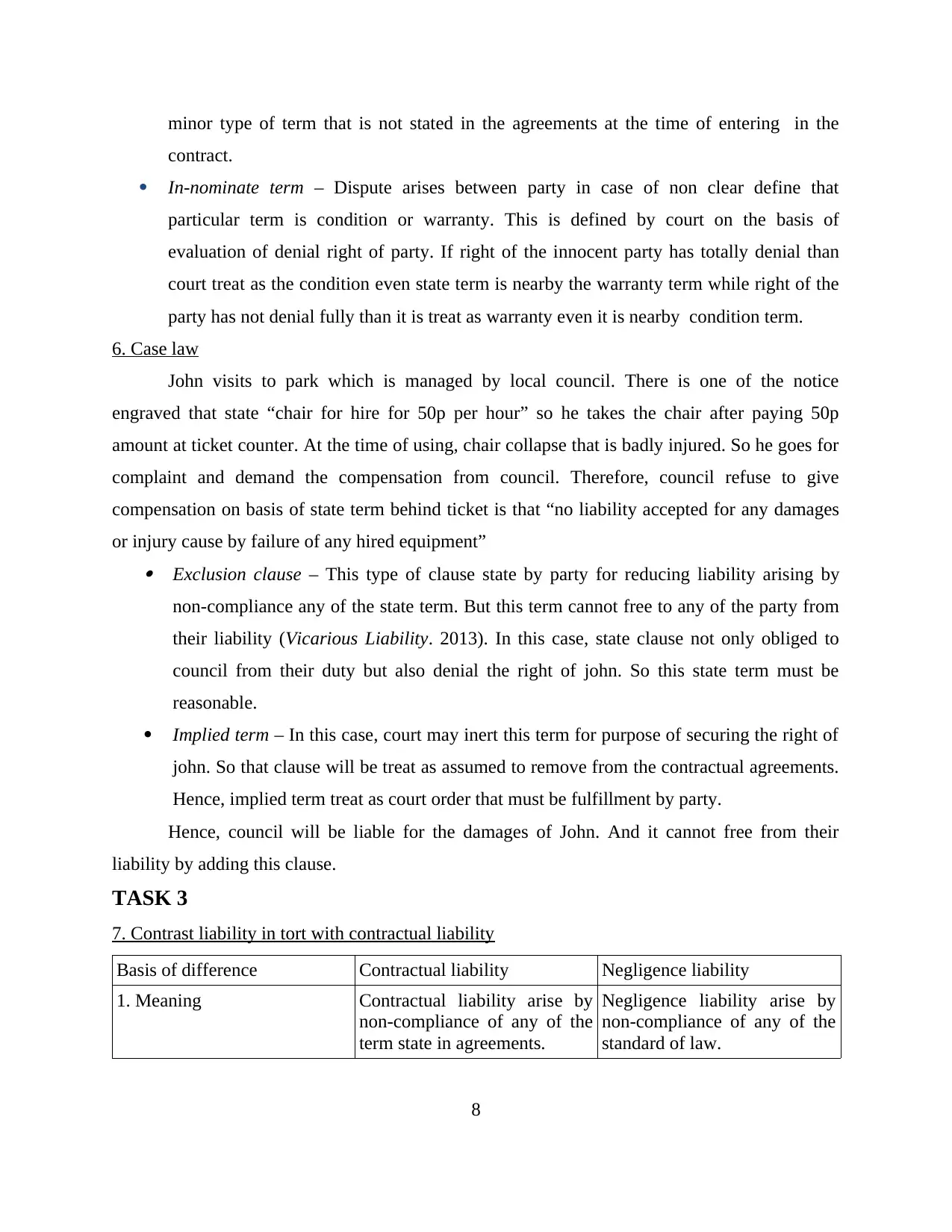
minor type of term that is not stated in the agreements at the time of entering in the
contract.
In-nominate term – Dispute arises between party in case of non clear define that
particular term is condition or warranty. This is defined by court on the basis of
evaluation of denial right of party. If right of the innocent party has totally denial than
court treat as the condition even state term is nearby the warranty term while right of the
party has not denial fully than it is treat as warranty even it is nearby condition term.
6. Case law
John visits to park which is managed by local council. There is one of the notice
engraved that state “chair for hire for 50p per hour” so he takes the chair after paying 50p
amount at ticket counter. At the time of using, chair collapse that is badly injured. So he goes for
complaint and demand the compensation from council. Therefore, council refuse to give
compensation on basis of state term behind ticket is that “no liability accepted for any damages
or injury cause by failure of any hired equipment” Exclusion clause – This type of clause state by party for reducing liability arising by
non-compliance any of the state term. But this term cannot free to any of the party from
their liability (Vicarious Liability. 2013). In this case, state clause not only obliged to
council from their duty but also denial the right of john. So this state term must be
reasonable.
Implied term – In this case, court may inert this term for purpose of securing the right of
john. So that clause will be treat as assumed to remove from the contractual agreements.
Hence, implied term treat as court order that must be fulfillment by party.
Hence, council will be liable for the damages of John. And it cannot free from their
liability by adding this clause.
TASK 3
7. Contrast liability in tort with contractual liability
Basis of difference Contractual liability Negligence liability
1. Meaning Contractual liability arise by
non-compliance of any of the
term state in agreements.
Negligence liability arise by
non-compliance of any of the
standard of law.
8
contract.
In-nominate term – Dispute arises between party in case of non clear define that
particular term is condition or warranty. This is defined by court on the basis of
evaluation of denial right of party. If right of the innocent party has totally denial than
court treat as the condition even state term is nearby the warranty term while right of the
party has not denial fully than it is treat as warranty even it is nearby condition term.
6. Case law
John visits to park which is managed by local council. There is one of the notice
engraved that state “chair for hire for 50p per hour” so he takes the chair after paying 50p
amount at ticket counter. At the time of using, chair collapse that is badly injured. So he goes for
complaint and demand the compensation from council. Therefore, council refuse to give
compensation on basis of state term behind ticket is that “no liability accepted for any damages
or injury cause by failure of any hired equipment” Exclusion clause – This type of clause state by party for reducing liability arising by
non-compliance any of the state term. But this term cannot free to any of the party from
their liability (Vicarious Liability. 2013). In this case, state clause not only obliged to
council from their duty but also denial the right of john. So this state term must be
reasonable.
Implied term – In this case, court may inert this term for purpose of securing the right of
john. So that clause will be treat as assumed to remove from the contractual agreements.
Hence, implied term treat as court order that must be fulfillment by party.
Hence, council will be liable for the damages of John. And it cannot free from their
liability by adding this clause.
TASK 3
7. Contrast liability in tort with contractual liability
Basis of difference Contractual liability Negligence liability
1. Meaning Contractual liability arise by
non-compliance of any of the
term state in agreements.
Negligence liability arise by
non-compliance of any of the
standard of law.
8
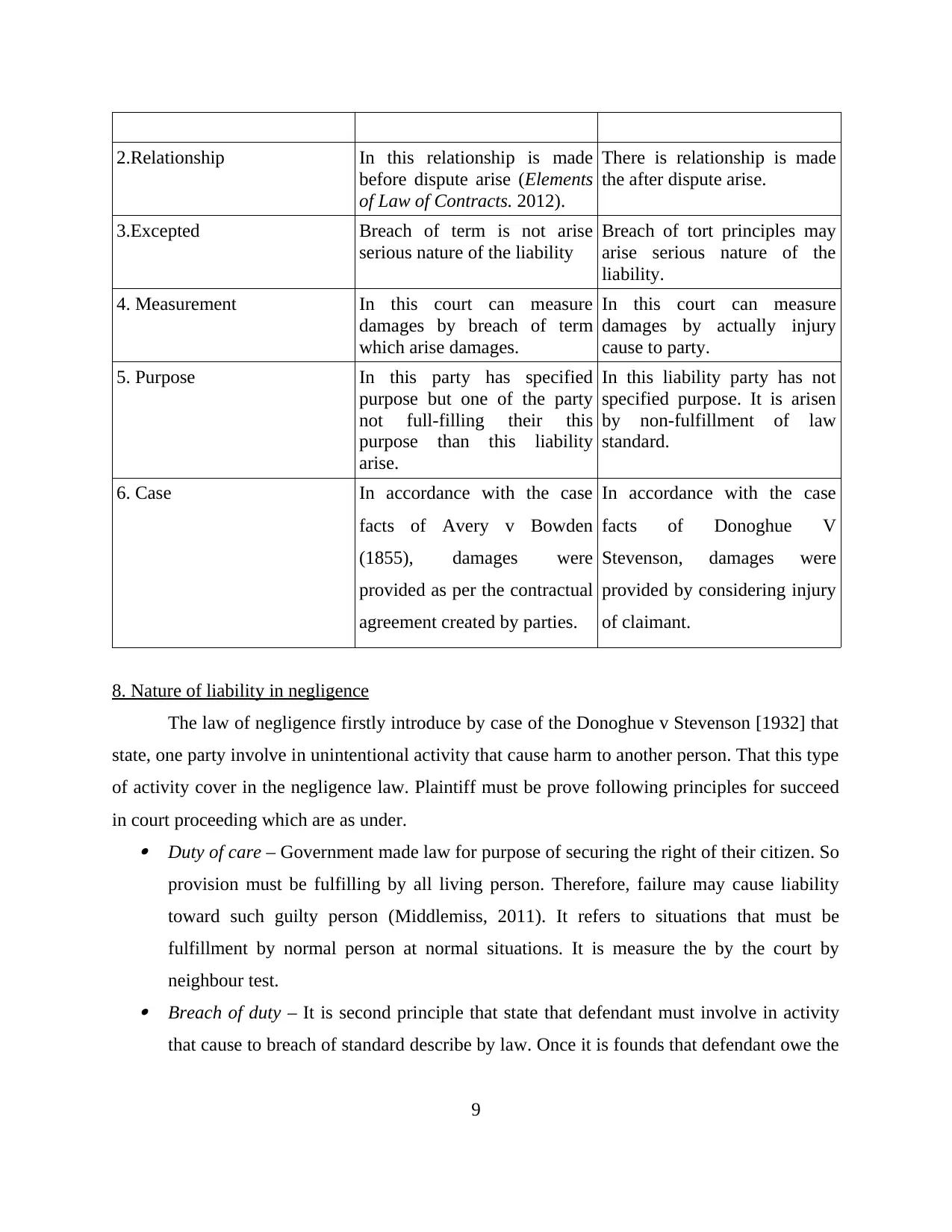
2.Relationship In this relationship is made
before dispute arise (Elements
of Law of Contracts. 2012).
There is relationship is made
the after dispute arise.
3.Excepted Breach of term is not arise
serious nature of the liability
Breach of tort principles may
arise serious nature of the
liability.
4. Measurement In this court can measure
damages by breach of term
which arise damages.
In this court can measure
damages by actually injury
cause to party.
5. Purpose In this party has specified
purpose but one of the party
not full-filling their this
purpose than this liability
arise.
In this liability party has not
specified purpose. It is arisen
by non-fulfillment of law
standard.
6. Case In accordance with the case
facts of Avery v Bowden
(1855), damages were
provided as per the contractual
agreement created by parties.
In accordance with the case
facts of Donoghue V
Stevenson, damages were
provided by considering injury
of claimant.
8. Nature of liability in negligence
The law of negligence firstly introduce by case of the Donoghue v Stevenson [1932] that
state, one party involve in unintentional activity that cause harm to another person. That this type
of activity cover in the negligence law. Plaintiff must be prove following principles for succeed
in court proceeding which are as under. Duty of care – Government made law for purpose of securing the right of their citizen. So
provision must be fulfilling by all living person. Therefore, failure may cause liability
toward such guilty person (Middlemiss, 2011). It refers to situations that must be
fulfillment by normal person at normal situations. It is measure the by the court by
neighbour test. Breach of duty – It is second principle that state that defendant must involve in activity
that cause to breach of standard describe by law. Once it is founds that defendant owe the
9
before dispute arise (Elements
of Law of Contracts. 2012).
There is relationship is made
the after dispute arise.
3.Excepted Breach of term is not arise
serious nature of the liability
Breach of tort principles may
arise serious nature of the
liability.
4. Measurement In this court can measure
damages by breach of term
which arise damages.
In this court can measure
damages by actually injury
cause to party.
5. Purpose In this party has specified
purpose but one of the party
not full-filling their this
purpose than this liability
arise.
In this liability party has not
specified purpose. It is arisen
by non-fulfillment of law
standard.
6. Case In accordance with the case
facts of Avery v Bowden
(1855), damages were
provided as per the contractual
agreement created by parties.
In accordance with the case
facts of Donoghue V
Stevenson, damages were
provided by considering injury
of claimant.
8. Nature of liability in negligence
The law of negligence firstly introduce by case of the Donoghue v Stevenson [1932] that
state, one party involve in unintentional activity that cause harm to another person. That this type
of activity cover in the negligence law. Plaintiff must be prove following principles for succeed
in court proceeding which are as under. Duty of care – Government made law for purpose of securing the right of their citizen. So
provision must be fulfilling by all living person. Therefore, failure may cause liability
toward such guilty person (Middlemiss, 2011). It refers to situations that must be
fulfillment by normal person at normal situations. It is measure the by the court by
neighbour test. Breach of duty – It is second principle that state that defendant must involve in activity
that cause to breach of standard describe by law. Once it is founds that defendant owe the
9
⊘ This is a preview!⊘
Do you want full access?
Subscribe today to unlock all pages.

Trusted by 1+ million students worldwide
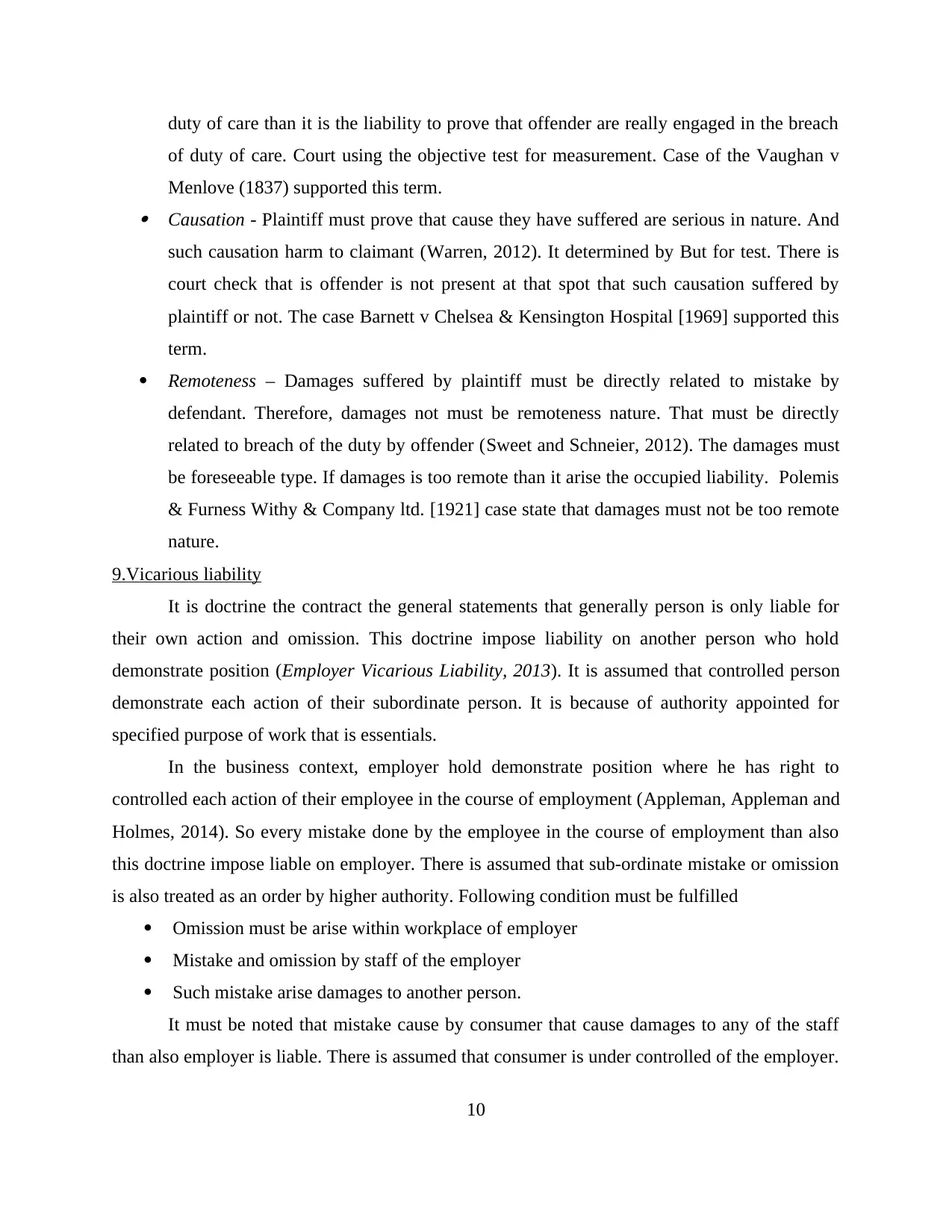
duty of care than it is the liability to prove that offender are really engaged in the breach
of duty of care. Court using the objective test for measurement. Case of the Vaughan v
Menlove (1837) supported this term. Causation - Plaintiff must prove that cause they have suffered are serious in nature. And
such causation harm to claimant (Warren, 2012). It determined by But for test. There is
court check that is offender is not present at that spot that such causation suffered by
plaintiff or not. The case Barnett v Chelsea & Kensington Hospital [1969] supported this
term.
Remoteness – Damages suffered by plaintiff must be directly related to mistake by
defendant. Therefore, damages not must be remoteness nature. That must be directly
related to breach of the duty by offender (Sweet and Schneier, 2012). The damages must
be foreseeable type. If damages is too remote than it arise the occupied liability. Polemis
& Furness Withy & Company ltd. [1921] case state that damages must not be too remote
nature.
9.Vicarious liability
It is doctrine the contract the general statements that generally person is only liable for
their own action and omission. This doctrine impose liability on another person who hold
demonstrate position (Employer Vicarious Liability, 2013). It is assumed that controlled person
demonstrate each action of their subordinate person. It is because of authority appointed for
specified purpose of work that is essentials.
In the business context, employer hold demonstrate position where he has right to
controlled each action of their employee in the course of employment (Appleman, Appleman and
Holmes, 2014). So every mistake done by the employee in the course of employment than also
this doctrine impose liable on employer. There is assumed that sub-ordinate mistake or omission
is also treated as an order by higher authority. Following condition must be fulfilled
Omission must be arise within workplace of employer
Mistake and omission by staff of the employer
Such mistake arise damages to another person.
It must be noted that mistake cause by consumer that cause damages to any of the staff
than also employer is liable. There is assumed that consumer is under controlled of the employer.
10
of duty of care. Court using the objective test for measurement. Case of the Vaughan v
Menlove (1837) supported this term. Causation - Plaintiff must prove that cause they have suffered are serious in nature. And
such causation harm to claimant (Warren, 2012). It determined by But for test. There is
court check that is offender is not present at that spot that such causation suffered by
plaintiff or not. The case Barnett v Chelsea & Kensington Hospital [1969] supported this
term.
Remoteness – Damages suffered by plaintiff must be directly related to mistake by
defendant. Therefore, damages not must be remoteness nature. That must be directly
related to breach of the duty by offender (Sweet and Schneier, 2012). The damages must
be foreseeable type. If damages is too remote than it arise the occupied liability. Polemis
& Furness Withy & Company ltd. [1921] case state that damages must not be too remote
nature.
9.Vicarious liability
It is doctrine the contract the general statements that generally person is only liable for
their own action and omission. This doctrine impose liability on another person who hold
demonstrate position (Employer Vicarious Liability, 2013). It is assumed that controlled person
demonstrate each action of their subordinate person. It is because of authority appointed for
specified purpose of work that is essentials.
In the business context, employer hold demonstrate position where he has right to
controlled each action of their employee in the course of employment (Appleman, Appleman and
Holmes, 2014). So every mistake done by the employee in the course of employment than also
this doctrine impose liable on employer. There is assumed that sub-ordinate mistake or omission
is also treated as an order by higher authority. Following condition must be fulfilled
Omission must be arise within workplace of employer
Mistake and omission by staff of the employer
Such mistake arise damages to another person.
It must be noted that mistake cause by consumer that cause damages to any of the staff
than also employer is liable. There is assumed that consumer is under controlled of the employer.
10
Paraphrase This Document
Need a fresh take? Get an instant paraphrase of this document with our AI Paraphraser
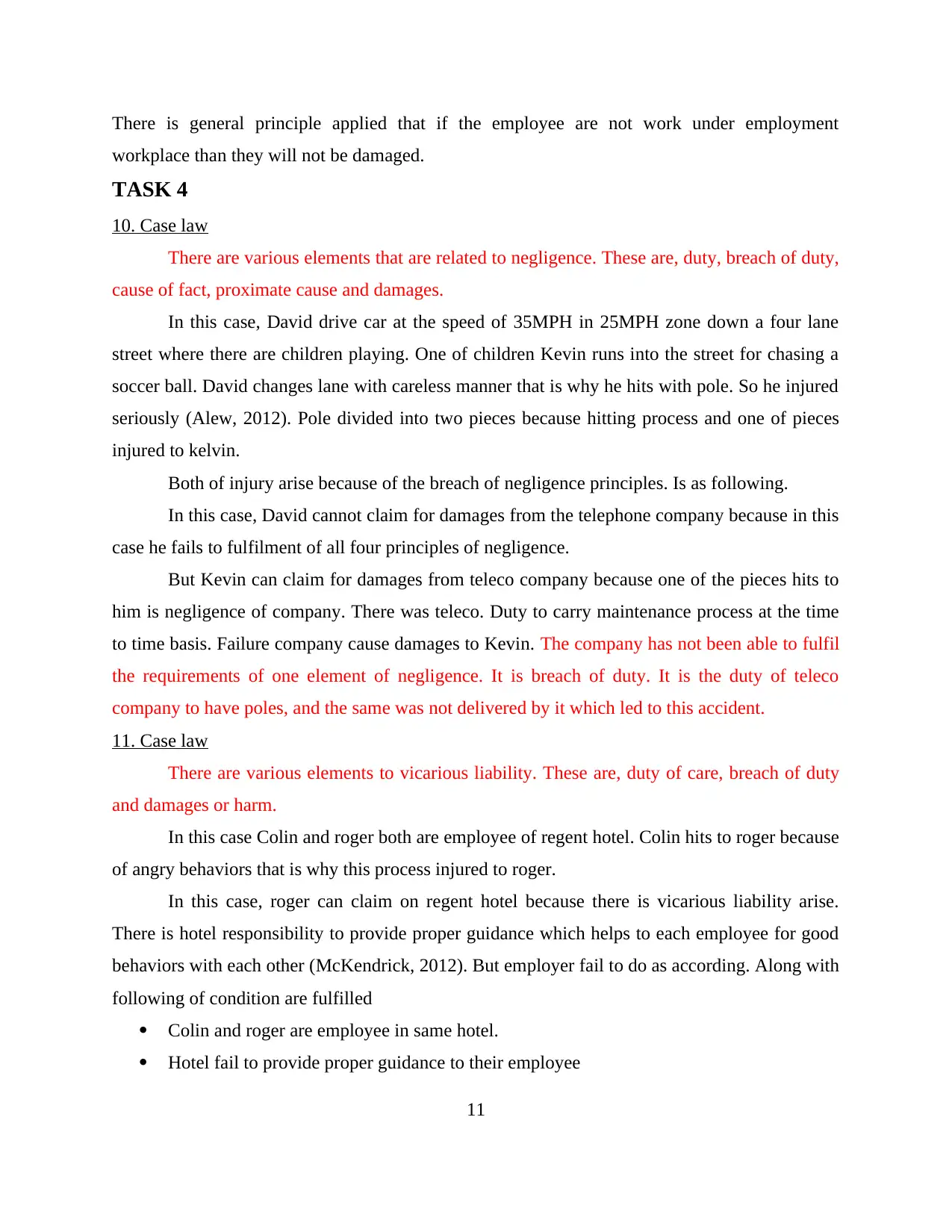
There is general principle applied that if the employee are not work under employment
workplace than they will not be damaged.
TASK 4
10. Case law
There are various elements that are related to negligence. These are, duty, breach of duty,
cause of fact, proximate cause and damages.
In this case, David drive car at the speed of 35MPH in 25MPH zone down a four lane
street where there are children playing. One of children Kevin runs into the street for chasing a
soccer ball. David changes lane with careless manner that is why he hits with pole. So he injured
seriously (Alew, 2012). Pole divided into two pieces because hitting process and one of pieces
injured to kelvin.
Both of injury arise because of the breach of negligence principles. Is as following.
In this case, David cannot claim for damages from the telephone company because in this
case he fails to fulfilment of all four principles of negligence.
But Kevin can claim for damages from teleco company because one of the pieces hits to
him is negligence of company. There was teleco. Duty to carry maintenance process at the time
to time basis. Failure company cause damages to Kevin. The company has not been able to fulfil
the requirements of one element of negligence. It is breach of duty. It is the duty of teleco
company to have poles, and the same was not delivered by it which led to this accident.
11. Case law
There are various elements to vicarious liability. These are, duty of care, breach of duty
and damages or harm.
In this case Colin and roger both are employee of regent hotel. Colin hits to roger because
of angry behaviors that is why this process injured to roger.
In this case, roger can claim on regent hotel because there is vicarious liability arise.
There is hotel responsibility to provide proper guidance which helps to each employee for good
behaviors with each other (McKendrick, 2012). But employer fail to do as according. Along with
following of condition are fulfilled
Colin and roger are employee in same hotel.
Hotel fail to provide proper guidance to their employee
11
workplace than they will not be damaged.
TASK 4
10. Case law
There are various elements that are related to negligence. These are, duty, breach of duty,
cause of fact, proximate cause and damages.
In this case, David drive car at the speed of 35MPH in 25MPH zone down a four lane
street where there are children playing. One of children Kevin runs into the street for chasing a
soccer ball. David changes lane with careless manner that is why he hits with pole. So he injured
seriously (Alew, 2012). Pole divided into two pieces because hitting process and one of pieces
injured to kelvin.
Both of injury arise because of the breach of negligence principles. Is as following.
In this case, David cannot claim for damages from the telephone company because in this
case he fails to fulfilment of all four principles of negligence.
But Kevin can claim for damages from teleco company because one of the pieces hits to
him is negligence of company. There was teleco. Duty to carry maintenance process at the time
to time basis. Failure company cause damages to Kevin. The company has not been able to fulfil
the requirements of one element of negligence. It is breach of duty. It is the duty of teleco
company to have poles, and the same was not delivered by it which led to this accident.
11. Case law
There are various elements to vicarious liability. These are, duty of care, breach of duty
and damages or harm.
In this case Colin and roger both are employee of regent hotel. Colin hits to roger because
of angry behaviors that is why this process injured to roger.
In this case, roger can claim on regent hotel because there is vicarious liability arise.
There is hotel responsibility to provide proper guidance which helps to each employee for good
behaviors with each other (McKendrick, 2012). But employer fail to do as according. Along with
following of condition are fulfilled
Colin and roger are employee in same hotel.
Hotel fail to provide proper guidance to their employee
11
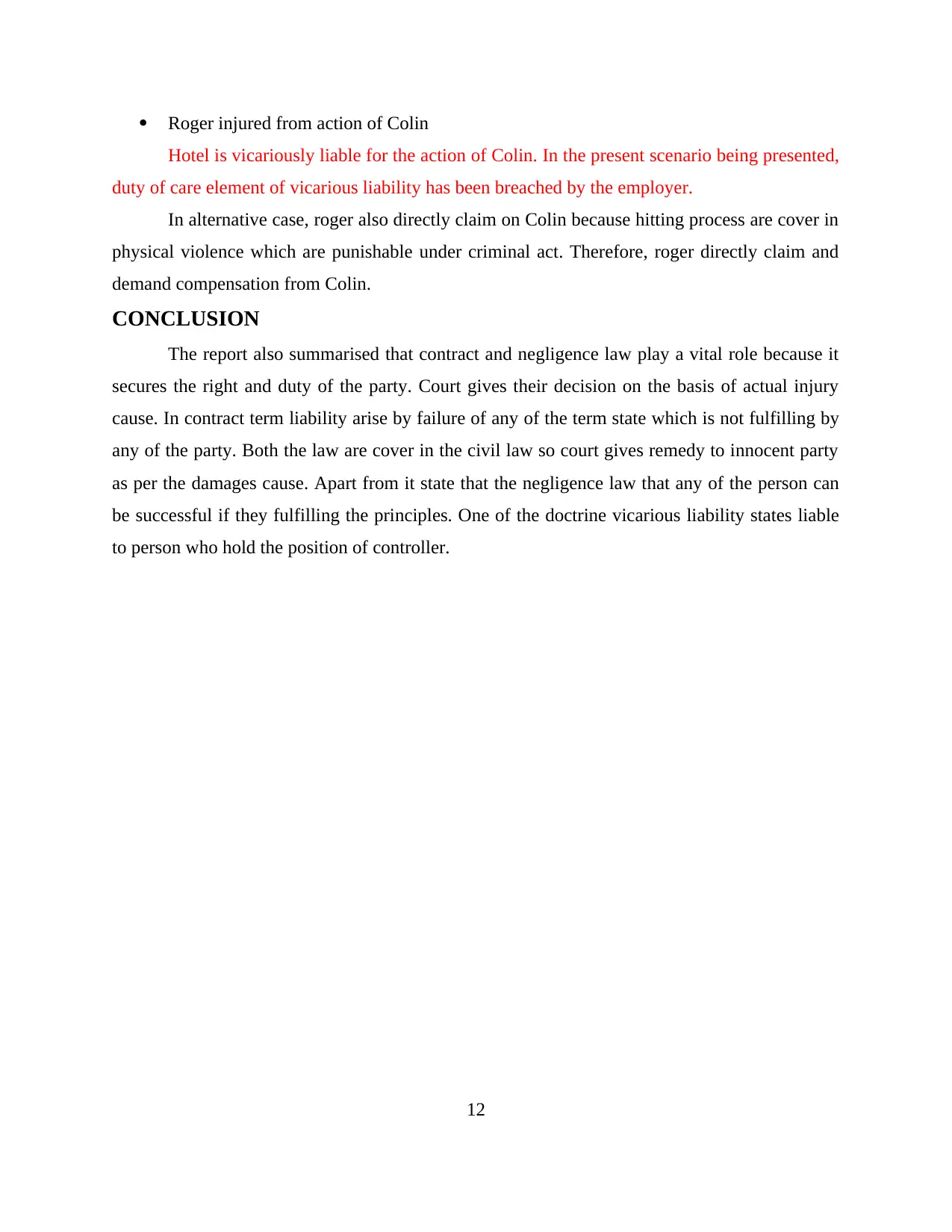
Roger injured from action of Colin
Hotel is vicariously liable for the action of Colin. In the present scenario being presented,
duty of care element of vicarious liability has been breached by the employer.
In alternative case, roger also directly claim on Colin because hitting process are cover in
physical violence which are punishable under criminal act. Therefore, roger directly claim and
demand compensation from Colin.
CONCLUSION
The report also summarised that contract and negligence law play a vital role because it
secures the right and duty of the party. Court gives their decision on the basis of actual injury
cause. In contract term liability arise by failure of any of the term state which is not fulfilling by
any of the party. Both the law are cover in the civil law so court gives remedy to innocent party
as per the damages cause. Apart from it state that the negligence law that any of the person can
be successful if they fulfilling the principles. One of the doctrine vicarious liability states liable
to person who hold the position of controller.
12
Hotel is vicariously liable for the action of Colin. In the present scenario being presented,
duty of care element of vicarious liability has been breached by the employer.
In alternative case, roger also directly claim on Colin because hitting process are cover in
physical violence which are punishable under criminal act. Therefore, roger directly claim and
demand compensation from Colin.
CONCLUSION
The report also summarised that contract and negligence law play a vital role because it
secures the right and duty of the party. Court gives their decision on the basis of actual injury
cause. In contract term liability arise by failure of any of the term state which is not fulfilling by
any of the party. Both the law are cover in the civil law so court gives remedy to innocent party
as per the damages cause. Apart from it state that the negligence law that any of the person can
be successful if they fulfilling the principles. One of the doctrine vicarious liability states liable
to person who hold the position of controller.
12
⊘ This is a preview!⊘
Do you want full access?
Subscribe today to unlock all pages.

Trusted by 1+ million students worldwide
1 out of 14
Related Documents
Your All-in-One AI-Powered Toolkit for Academic Success.
+13062052269
info@desklib.com
Available 24*7 on WhatsApp / Email
![[object Object]](/_next/static/media/star-bottom.7253800d.svg)
Unlock your academic potential
Copyright © 2020–2025 A2Z Services. All Rights Reserved. Developed and managed by ZUCOL.





